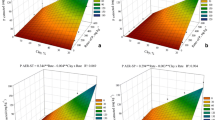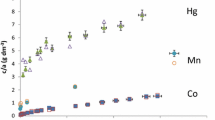Abstract
The ammonia electrode serves as the basis of a simple, accurate method for determination of cation exchange capacity of small (ca. 50 mg) samples of clays. The technique is also capable of accurate measurement of CEC values on the order of 0·01 m-equiv/100 g if larger (ca. 500 mg) samples are used. The procedure, which requires saturation of the exchange sites with ammonium as in the usual methods, utilizes the electrode in the determination of ammonia released by treatment of the ammonium clay by strong base. For a Wyoming bentonite, the technique gave a CEC of 86 m-equiv/100 g with an S.D. (four determinations) of 0·83 m-equiv/100 g. Duplicate runs on the same sample by the conventional Kjeldahl method gave results of 86·0 and 85·5 m-equiv/100 g.
Résumé
L’électrode à ammoniaque sert de base à une méthode simple et précise pour la détermination de la capacité d’échange de petits échantillons d’argile (environ 50 mg). La technique permet également de mesurer avec précision les valeurs de CEC de l’orde de 0,01 meq/100 g si des échantillons plus importants (environ 500 mg) sont utilisés. Ce procédé, qui nécessite la saturation des sites d’échange avec l’ammonium comme dans le cas des méthodes habituelles, utilise l’électrode dans le but de doser l’ammoniaque libérée par l’argile ammonium lors d’un traitement par une base forte. Pour une bentonite du Wyoming, cette technique a donné une CEC de 86 m-equiv./100 g avec une déviation standard (quatre dosages) de 0,83 m-equiv./100 g. Des doubles effectués sur le même échantillon par la methode Kjeldahl conventionnelle ont donné comme résultats 86,0 et 85,5 m-equiv./100 g.
Kurzreferat
Die Ammoniumelektrode dient als Grundlage einer einfachen, genauen Methode zur Bestimmung der Kationenaustauschkapazität kleiner (ca 50 mg) Tonproben. Die gleiche Technik ist auch zur genauen Bestimmung von Austauschkapazitätswerten in der Größenordnung von 0,01 mval/100 g geeignet, wenn größere Probenmengen (ca 500 mg) benutzt werden. Bei dem Verfahren, das eine Sättigung der Austauschpläitze mit Ammoniumionen wie bei den üblichen Methoden erfordert, wird die Elektrode zur Bestimmung des durch Behandlung des Ammonium-Tons mit starken Basen freigesetzten Ammoniums eingesetzt. Für einen Wyoming-Bentonit ergab die Methode eine Austauschkapazit t von 86 m-val/100 g mit einer Standardabweichung (4 Bestimmungen) von 0,83 mval/100 g. Parallelbestimmungen an der gleichen Probe mit der konventionellen Kjeldahl-Methode ergaben 86,0 und 85,5 m-val/100 g.
Резюме
Аммиачный электрод служит основанием простого и точного метода определения способности катионообмена небольших образцов глины (са 50 мг). Этим способом можно также аккуратно вымерять значения СЕС порядка 0,01 мек/100 г, если использовать более крупные образцы (са 500 мг). Процедура, требующая насыщения аммиаком обменных узлов как и по обычным методам, применяет электрод для определения выделенного аммиака обработкой аммиачной глины крепким основанием. Этот способ для вайомингского бетонита дал СЕС порядка 86 мек/100 г со стандартными отклонениями (четыре определения) 0,83 мек/100 г. Дублированные опыты с этим же образцом стандартным методом кджелдала дали следующие результаты: 86,0 и 85,5 мек/100 г.
Similar content being viewed by others
References
Anonymous (1972) Instructional Manual; Ammonia Electrode Model 95–10: Orion Research Inc., Cambridge, Mass. 24 pp.
Chapman, H. D. (1965) Cation exchange capacity. In Methods of Soil Analysis (Edited by Black, C. A.) Part 2, pp. 891–901. Number 9 in the series Agronomy: Am. Inst. Agronomy, Madison, Wisconsin.
Durst, R. A. (Editor) (1969) Ion Selective Electrodes: National Bureau of Standards Publication 314, 452 pp. Superintendent of Documents, Washington, D.C.
Hinckley, D. N. (1962) An X-ray spectrographic method for measuring base exchange capacity: Amer. Mineralogist 47, 993–996.
Kennedy, V. C. and Brown, T. E. (1964) Experiments with a sodium-ion electrode as a means of studying cation-exchange rates. Clays and Clay Minerals, 13, 351–352.
Mackenzie, R. C. (1951) A micromethod for the determination of cation exchange capacities of clays: J. Colloid Sci. 6, 219–222.
Malcolm, R. L. and Kennedy, V. C. (1969) Rate of cation exchange on clay minerals as determined by specific ion electrode techniques: Soil Sci. Soc. Am. Proc. 33 (2), 247–253.
Malcolm, R. L., Kennedy, V. C. and Jenne, E. A. (1969) Determination of cation exchange capacity with the potassium specific ion electrode: Int. Clay Conf. Proc., Tokyo 1, 573–583.
Malcolm, R. L. and Kennedy, V. C. (1970) Variation of cation exchange capacity and rate with particle size in stream sediment: J. Water Pollut. Control Fed., Part 2, R153–R160.
Moody, G. J. and Thomas, J. D. R. (1971) Selective Ion Sensitive Electrodes: Merrow Publishing Co., London, 140 pp.
Mortland, M. M. (1961) Using a glass electrode for estimating exchangeable potassium in soils: Michigan Agric. Experiment Station Quarterly Bull. 43 (3), 491–498.
Pham Thi Hang and Brindley, G. W. (1970) Methylene blue absorption by clay minerals. Determination of surface areas and cation exchange capacities. Clays and Clay Minerals 18, 203–212.
Author information
Authors and Affiliations
Rights and permissions
About this article
Cite this article
Busenberg, E., Clemency, C.V. Determination of the Cation Exchange Capacity of Clays and Soils Using an Ammonia Electrode. Clays Clay Miner. 21, 213–217 (1973). https://doi.org/10.1346/CCMN.1973.0210403
Received:
Published:
Issue Date:
DOI: https://doi.org/10.1346/CCMN.1973.0210403




